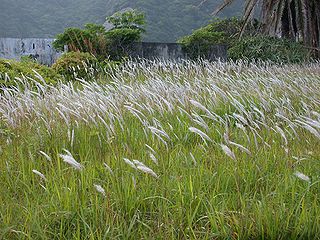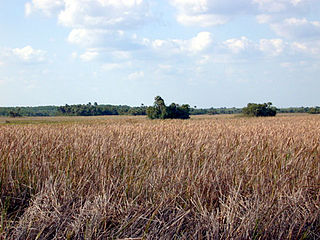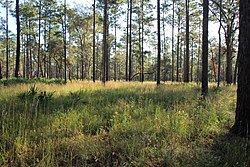
The longleaf pine is a pine species native to the Southeastern United States, found along the coastal plain from East Texas to southern Virginia, extending into northern and central Florida. In this area it is also known as "yellow pine" or "long leaf yellow pine", although it is properly just one out of a number of species termed yellow pine. It reaches a height of 30–35 m (98–115 ft) and a diameter of 0.7 m (28 in). In the past, before extensive logging, they reportedly grew to 47 m (154 ft) with a diameter of 1.2 m (47 in). The tree is a cultural symbol of the Southern United States, being the official state tree of Alabama. This particular species is one of the eight pine tree species that falls under the "Pine" designation as the state tree of North Carolina.

Pinus elliottii, commonly known as slash pine, is a conifer tree native to the Southeastern United States. Slash pine is named after the "slashes" – swampy ground overgrown with trees and bushes – that constitute its habitat. Other common names include swamp pine, yellow slash pine, and southern Florida pine. Slash pine has two different varieties: P. e. var. elliottii and P. e. var. densa. Historically, slash pine has been an important economic timber for naval stores, turpentine, and resin. The wood of slash pine is known for its unusually high strength, especially for a pine. It exceeds many hardwoods and is even comparable to very dense woods such as ironwood.

Weymouth Woods-Sandhills Nature Preserve is a North Carolina state park in Moore County, North Carolina in the United States. Located near Southern Pines, North Carolina, it covers 915 acres (3.70 km2) in the Sandhills region of the state.

Flatwoods, pineywoods, pine savannas and longleaf pine–wiregrass ecosystem are terms that refer to an ecological community in the southeastern coastal plain of North America. Flatwoods are an ecosystem maintained by wildfire or prescribed fire and are dominated by longleaf pine, and slash pine in the tree canopy and saw palmetto, gallberry and other flammable evergreen shrubs in the understory, along with a high diversity of herb species. It was once one of the dominant ecosystem types of southeastern North America. Although grasses and pines are characteristic of this system, the precise composition changes from west to east, that is, from Texas to Florida. In Louisiana, savannas even differ between the east and west side of the Mississippi River. The key factor maintaining this habitat type is recurring fire. Without fire, the habitat is eventually invaded by other species of woody plants.

The Sandhills or Carolina Sandhills is a 10-35 mi wide physiographic region within the U.S. Atlantic Coastal Plain province, along the updip (inland) margin of this province in the states of North Carolina, South Carolina, and Georgia. The extent of the Carolina Sandhills is shown in maps of the ecoregions of North Carolina, South Carolina, and Georgia.

The Ocala National Forest is the second largest nationally protected forest in the U.S. State of Florida. It covers 607 square miles (1,570 km2) of northern Florida. It is located three miles (5 km) east of Ocala and 16 miles (26 km) southeast of Gainesville. The Ocala National Forest, established in 1908, is the oldest national forest east of the Mississippi River and the southernmost national forest in the continental U.S. The word Ocala is thought to be a derivative of a Timucuan term meaning "fair land" or "big hammock". The forest is headquartered in Tallahassee, as are all three National Forests in Florida, but there are local ranger district offices located in Silver Springs and Umatilla.

Imperata cylindrica is a species of perennial rhizomatous grass native to tropical and subtropical Asia, Micronesia, Melanesia, Australia, Africa, and Southern Europe. It has also been introduced to Latin America, the Caribbean, and the Southeastern United States. It is a highly flammable pyrophyte, and can spread rapidly by colonizing disturbed areas and encouraging more frequent wildfires.

Hammock is a term used in the southeastern United States for stands of trees, usually hardwood, that form an ecological island in a contrasting ecosystem. Hammocks grow on elevated areas, often just a few inches high, surrounded by wetlands that are too wet to support them. The term hammock is also applied to stands of hardwood trees growing on slopes between wetlands and drier uplands supporting a mixed or coniferous forest. Types of hammocks found in the United States include tropical hardwood hammocks, temperate hardwood hammocks, and maritime or coastal hammocks. Hammocks are also often classified as hydric, mesic or xeric. The types are not exclusive, but often grade into each other.
Sand Hill, Sandhill, Sand Hills, or Sandhills may refer to:

The Atlantic Plain is one of eight distinct physiographic divisions of the contiguous United States. Using the USGS physiographic classification system, the Atlantic Plain division comprises two provinces and six sections. The Coastal Plain province is differentiated from the Continental Shelf province simply based on the portion of the land mass above and below sea level.

Florida scrub is a forest ecoregion found throughout Florida in the United States. It is found on coastal and inland sand ridges and is characterized by an evergreen xeromorphic plant community dominated by shrubs and dwarf oaks. Because the low-nutrient sandy soils do not retain moisture, the ecosystem is effectively an arid one. Wildfires infrequently occur in the Florida scrub. Most of the annual rainfall falls in summer. It is endangered by residential, commercial and agricultural development, with the largest remaining block in and around the Ocala National Forest. Lake Wales Ridge National Wildlife Refuge also holds a high proportion of remaining scrub habitat, while the Archbold Biological Station near Lake Placid contains about 20 km2 (7.7 sq mi) of scrub habitat and sponsors biological research on it.

The gopher frog is a species of frog in the family Ranidae, endemic to the south-eastern United States. It primarily inhabits the threatened sandhill communities, flatwoods, and scrub in the Atlantic coastal plain, where it is usually found near ponds.

The eastern woodlands of the United States covered large portions of the southeast side of the continent until the early 20th century. These were in a fire ecology of open grassland and forests with low ground cover of herbs and grasses.

Pre-Columbian woodlands of North America, consisting of a mixed woodland-grassland ecosystem, were maintained by both natural lightning fires and by Native Americans before the significant arrival of Europeans. Although decimated by widespread epidemic disease, Native Americans in the 16th century continued using fire to clear woodlands until European colonists began colonizing the eastern seaboard. Many colonists continued the practice of burning to clear underbrush, reinforced by their similar experience in Europe, but some land reverted to forest.
Chrysopsis delaneyi, or DeLaney's goldenaster, is one of the endemic species to the U.S. state of Florida, recently discovered in the genus Chrysopsis, a small group of herbaceous plants of the family Asteraceae, known commonly as the "golden asters" and primarily native and restricted to Florida.

The Carolina Sandhills National Wildlife Refuge is a 45,348-acre (183.52 km2) national wildlife refuge (NWR) located in Chesterfield County, South Carolina. The refuge is managed by the U.S. Fish and Wildlife Service from a headquarters located in McBee, South Carolina. The refuge is served by U.S. Highway 1, which passes through it.

The Southeastern conifer forests are a temperate coniferous forest ecoregion of the southeastern United States. It is the largest conifer forest ecoregion east of the Mississippi River. It is also the southernmost instance of temperate coniferous forest within the Nearctic realm.
The Florida longleaf pine sandhill is a forest system found on sandhills in the coastal plains of northern Florida, ranging from the panhandle to the central peninsula. Particular examples can be found in Ocala National Forest, Withlacoochee State Forest, Mike Roess Gold Head Branch State Park, and Eglin Air Force Base.
The Southern coastal plain oak dome and hammock is a forest type occurring in small patches in Florida, Georgia, Alabama, and Mississippi. These forests consist of thick stands of evergreen oaks on shallow depressions or slight hills. They are distinct from their surrounding habitats, which are often woodlands dominated by longleaf pine.

The longleaf pine ecosystem is a temperate coniferous forest ecosystem found within the Southern United States. Spanning pine savannas, sandhills and montane forests, it includes many rare plant and animal species, and is one of the most biodiverse in North America. Once one of the largest ecosystems in North America, from Virginia south to Florida and east to Texas, it now occupies less than a quarter of the original range. Degradation of the ecosystem is partially due to excessive timber harvesting, urbanization, and fire exclusion. Although the ecosystem is heavily fragmented at present, it still carries a great diversity of plant and animal species, many of which are endemic. A range of techniques, including planting longleaf pine seedlings, introducing prescribed burning regimens, managing native ground cover, and controlling invasive species within the ecosystem, are used in attempting to preserve this threatened ecosystem.














